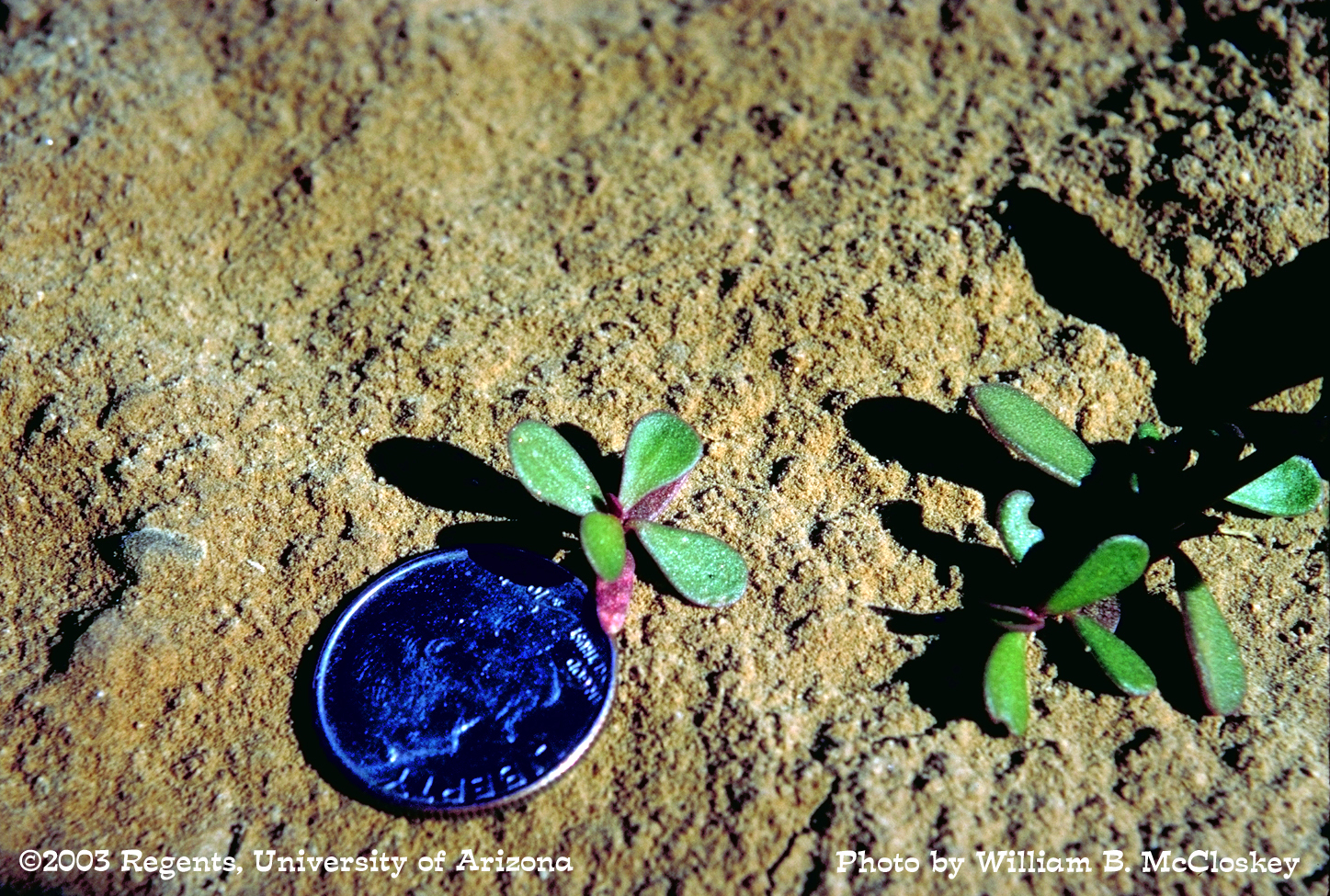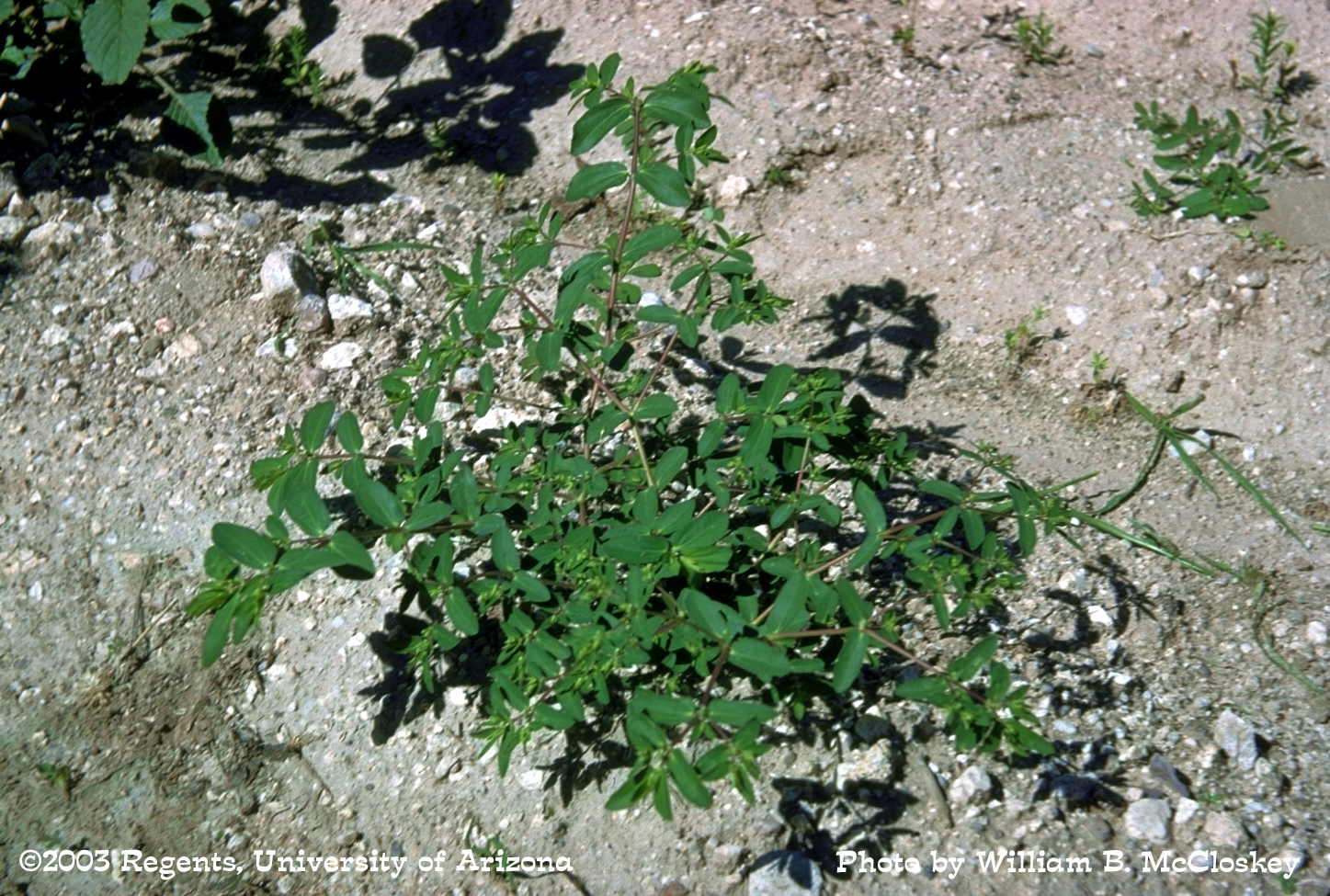Spring means warmer weather, whether you are in Flagstaff, or Yuma. Turfgrass weeds that must come up from seeds and then die later are called “annuals”. There are two categories of annual weeds. There are “summer”, and “winter” annual weeds. Summer annual weeds germinate from seed in late winter or early spring, and then thrive through the summer months, which includes the production of more seed to come up for the next year !
In cases where the same annual weeds come up year after year, it is actually easier to prevent annual weeds from becoming established at all by using a preemergence herbicide, than to treat them after they come up with a “post emergence” weed control product.

Emerging Purslane
Pre-emergence herbicides actually allow germination to occur, which is separate from emergence. Actually emergence is the first visible sign of a leaf and shoot to reach the soil surface after germination (inside the seed) has occurred. In most cases, pre-emergence herbicides stop the seedling root from growing, which prevents the emergence of the shoot that you “don’t see”.
For pre-emergence herbicides to work, the product has to be applied evenly across the turf, since most products (and their active ingredients) move very little in lateral distance after being applied and then being “irrigated in”. Right after the actual application, the amount of time that is allowed to expire before the product is watered in can also be critical. Certain active ingredient/formulation combinations must be watered in very soon after application, so they can bind to the soil before the active ingredient gets lost to sunlight, or to the air itself.
On the product label are written recommendations that address the “watering window”, which is the time span that irrigation (or rainfall) is necessary after 2 application is made to avoid such losses. After that, if rain or irrigation does not occur, weed control will be minimized. Active ingredients that can stay “dry” for 21 days or so after application include surflan (oryzalin) and the “aqua-cap” formulation of pendimethalin.
There are several active ingredients which are often sold under a variety of product names, since different product names are aligned with different unique sellers.
Common active ingredients of pre-emergence herbicides often include the following:
Summer annual grassy weeds include (at low desert locations) southwest cupgrass, liverseed grass, stink grass, and sometimes crabgrass. At higher elevations like Prescott and Phoenix, crabgrass is a major summer annual grass weed. The above active ingredients are predominately active against grassy weeds. For some active ingredients, there is some pre-emerge activity against the annual summer spurges, which are actually summer broadleaf weeds. This is usually achieved when the high label rate is applied, and when followed by a second follow up application (when allowed as stated on the label). The active ingredient isoxaben, is very active against broadleaf weed seeds, and as such may be included as an active ingredient addition in some weed control mix products. Some active ingredients may also have post emergence activity as well. This may be possible when the newly emerged weeds are young and small. Such information is also included on the label.

Hyssop Spurge
Pre-emergence weed control products are applied when the soil temperature is around 50-55 F or so. Normally, pre-emergence herbicides should applied by the 3 end of February/early March in Tucson and Phoenix, and by early to mid-February in Yuma. Likewise, this time occurs in mid-May in Flagstaff. Soil temperatures can be found at the following web site http://cals.arizona.edu/AZMET/. Click on the [Data Archive] box, then pick the “location” in question, then select “weekly reports”. Soil temps at 2.0 inches are listed in columns headed as Soil Temp at 2” inches, or as “ST2”, depending on file type.
When shopping at garden centers, notice that that the “product name” may not always portray a reasonable resemblance to the type of intended use for the product. In other words, the name of the weed control product may or may not be indicative of what the application is intended for. As an example “ weed preventer “ infers logically that it “prevents weeds from coming up and is probably a pre-emergence herbicide, while “weed stopper” sounds like it may stop weeds from coming out of the ground, (pre-emerge) , or also it may be a post emergent product. In fact “weed stopper” is a pre-emergent product with the active ingredient of trifluralin (treflan).
Some pre-emergence herbicides are also formulated with the active ingredient attached to a granular fertilizer. This can offer some convenience since a fertilizer application can be made when applying suitable pre-emergence weed control agent. These types of products are often referred to as “weed and feed” products. There are other active ingredients used in turfgrass pre-emergence weed control, but they are not labeled for homeowner purchase/use (not included here). These are known as restricted use products, and must be applied by a certified applicator. Note that some active ingredients available to homeowners may not be sold at box stores or even at local nurseries, but may still be available at landscape product dealerships, often in a concentrated form and greater purchase expense, even though the cost per unit of active ingredient in this case is always cheaper than the “ready to use” or “easy to use” (minimal dilution) products sold at garden center and box stores. The purchase depends on how large the lawn is, how many times the product will be used and overall convenience. Also, note that pre-emergence weed control products are also available to the public on web sites, which sometimes offer more active ingredient mixes than what is normally available at hard commerce purchase locations.